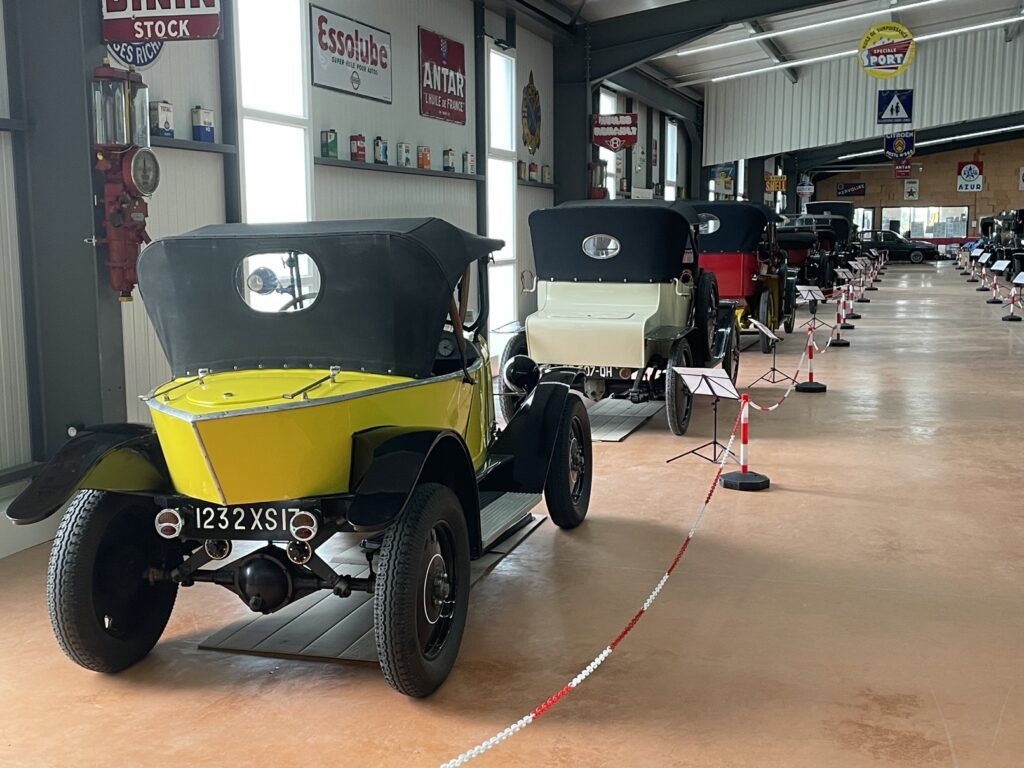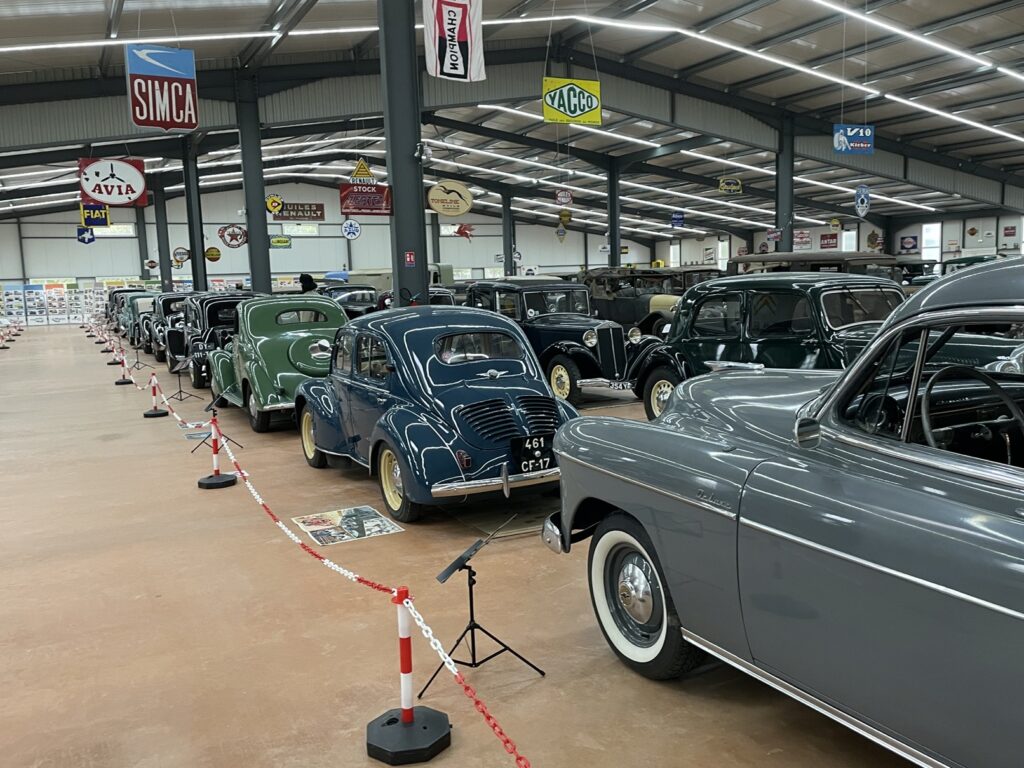

Aunis Automobile Museum history
The Aunis Automobile Museum takes its name from its location, a French historical and cultural region, corresponding today to the north-western quarter of the Charente-Maritime department. Previously museum of Ciré d’Aunis, it changed its name when it moved a few km in 2022. Gilles Gaudissart, the owner, started his collection by chance, like many collectors. He bought an old car in 1991, in this case a Citroën Traction in poor condition that he undertaked to restore. The passion was born for old cars and their restoration. Others will follow, and the man finds himself with a collection that he decides to share with the public by opening a museum. The first place opens in 2019 in Ciré d’Aunis, on 700 m² then 1000 m² of former workshops. However, the site quickly proved too small to properly present the collection, and Gilles Gaudissart embarked on a project to build a larger building designed specifically for his collection. The goal is on the one hand to show more cars, and also to better highlight them. Conducted over nearly 3 years, the project will lead to the opening of the new venue in the summer of 2022, a few kilometers from Ciré d’Aunis, hence the name change. It presents a hundred cars, with the collection of Gilles Gaudissart and some cars loaned by local collectors.
My Favorites
In such a museum, each visitor will stop on one car or another, depending on the memories, passions or emotions it evokes. Some favorites to distinguish, but always subjective:
- Citroën Type C 1924, bright yellow
- Mercedes 190 SL Convertible 1960, superb in red with black leather interior
- 1948 Talbot Lago T26, which exudes power and luxury
- Peugeot 301D spider 1935 with its amazing hot-rod style
Museum presentation
The Aunis Automobile Museum is now housed in a large functional building of more than 3500m², easily accessible from Rochefort or La Rochelle. A very large car park makes it easy to accommodate club visits, and the building has been designed to allow access for disabled people. After the reception which offers a small shop and the possibility of having a coffee or a cold drink, we enter a very large hall and we discover the collection. Few pillars so as not to obstruct the view, bay windows and roof windows leave in the light, the lighting being complemented by large LED ramps. The hall is thus very bright, without the light generating parasitic reflections on the bodies. Gilles Gaudissart chose to arrange the cars in double lanes, with enough space between them to observe them well. The other choice was to arrange them in chronological order, which makes it possible to follow the evolution of style and automotive techniques. The vast majority of cars on display are in working order and ready to go. However, an island in the center shows some cars in their original juice or with a beginning of restoration, which allows the visitor to take the measure of the restoration work. If it favors French cars and exhibits many brands now disappeared, including some local curiosities, the museum also has some beautiful cars from Europe or the United States. For each car, a small descriptive sheet (French / English) gives some details on the model, origin, engine, production volume...





The visit
Respecting the choice of presentation of the museum, we will also explore the collection in chronological order, at least by major periods. It will not be a question of detailing each car, but rather of dwelling on a few rarer models or, those that particularly interested me, even if all cars are worthy of interest, and that according to your tastes or memories, you will be more attracted by other models.
Cars until 1930
The oldest is not quite, since it is a reproduction of an English propeller car from 1910. Inspired by the nascent aeronautics, several manufacturers tried propeller traction, the best known than the French Helica, of which models can be found in several museums. In addition to Citroën, Peugeot and Renault, there are also disappeared brands such as Delage or Panhard & Levassor, and others whose trace has often faded from our memories.







The Renault AG1 (1912 for this model) is the Parisian taxi of pre-war, and it will get famous in history as the “Taxi de la Marne” when 2500 taxis will be requisitioned in 1914 by the French army to transport soldiers to the front. Another car distinguished itself during the war, the Zebra Type C used by the General staff, which ordered their destruction at the end of the war, and the model on display is one of the only 2 survivors! The Amilcar was limited to 350kg to avoid taxes, while Mathis had adopted the slogan “weight, that’s the enemy” that Colin Chapman (creator of Lotus) will take up with his “light is right”!
The 1924 Citroën type C, famous for its pointed rear, convertible version in its famous lemon-yellow color was one of the very first mass-produced cars in Europe. From the 1920s, customers were looking for the comfort of a closed car, as opposed to open torpedos, and Delage (DS 1922 and DR 70 1929), De Dion Bouton (IM 1924), Talbot (K74 1929) or Panhard & Levassor (X68 1930) offered sedans or limousines equipped with powerful 6-cylinder engines. Note on the Delage DS and Talbot the elegant thermostatic grilles, whose flaps are activated automatically according to the need for engine cooling, a feature used again in recent years to improve aerodynamics.






Let’s also mention on this period 2 foreign cars that slipped into the collection, the famous Ford T, here a coupe doctor of 1927, one of the last models manufactured, and a Fiat 520 in an original body and unique convertible-spider from England. Another unique body, a little strange to tell the truth, is that of a Citroën C2 of 1924, rebodied in the years 1930/1940 in coupe 2 seats “short chassis”.






1930 to 1950
The first mention of this period goes to the Citroën Traction 7C. It is a fairly common car despite its age, but it is above all Gilles Gaudissart’s first vintage car, his first complete restoration, and which is still part of the exhibition. 2 other Traction are on display, a 15/6 with a 6-cylinder engine from 1949, nicknamed in its time “the queen of the road” for its performance, handling and comfort. The 3rd is a commercial 7 UA, equipped with a special wood and steel body that distinguishes it from the classic lines of the Traction.
To stay with the “queens of the road” proposed in this period, 2 cars stand out, the Rolls Royce 20/25 of 1933 and the Talbot Lago T26 of 1948. At that time, Rolls Royce delivered bare chassis to coachbuilders, and it is built in a Trupp & Maberly aluminum body, two-tone red and black. Imposing 6-cylinder in-line engine, thermostatic grille, with its red RR logo. After 1933 and the death of Henri Royce, this logo turned black. Another special feature is that the radiator’s mascot, the famous Spirit of Ecstasy, rotates 90 degrees to open the hood.






With its “over-profiled coach” body, its large hood housing a 4.5L in-line 6-cylinder delivering 170hp, the very elegant Talbot Lago T26 coupe was the most expensive and powerful car of the 1948 Paris Motor Show! The car is in exceptional condition, with only 30,000 km on the clock! A little less powerful, a Hotschkiss AM 80S convertible from 1936, also 6 cylinders, with a characteristic horseshoe radiator grille, witness to the manufacturer’s passion for horses. The Delahaye 134 (1935) is distinguished by a two-tone brown body, but above all without a central pillar between the antagonistic doors, opening onto a beautiful leather and wood interior.
La Licorne (Unicorn) (also known as Corre-La Licorne) is a defunct brand, but it produced more than 30,000 cars in nearly half a century of existence. The MV2 of 1930 is a small torpedo, while the 316 Rivoli sedan (1937) and the 419 Week end convertible (1939) are based on a house chassis with a body and engine derived from the Citroën Traction.







In the 1930s, the spider refers to a trunk located behind the cockpit that offers 2 seats in very relative comfort. Later, the term (with an i – spider – or a y – spyder – depending on the modes) will designate a convertible. There are some examples with 2 Renault and 2 Peugeot. The Renault Celtaquatre of 1935 is a small coupe, equipped with a 4-cylinder 1.5L, while the Vivasport represents the top of the range Renault with its 6-cylinder inline, especially in this roadster version. A coupe and a roadster for Peugeot too, with this lowered spider 301D coupe (1935), which would almost be taken for a hot-rod transformation. The 402 roadster (1937), recognizable by its grille which houses the 2 headlights in the center, is a rare version since less than 600 units were produced. Note on these spiders the small boards at the back and on the wings, intended to ease (???) access to the spider seats.





The BMW 327/28 (1938) convertible is another rare model (less than 600 units produced), sporty and elegant, and which shone in competition. Also sporty, even rarer (80 units), the Georges Irat MM of 1935 is a nice little roadster competitor of English productions, renowned for its handling. Note the open floor that lightens even more the car.
3 cars manufactured in France have transalpine accents, the Lancia Belna (1936) was a Lancia Augusta, built in France to avoid import taxes, while the 2 Simca are Fiat models rebadged and manufactured in France, the Simca 5 coupé convertible being none other than a Fiat Topolino. Finally, let’s mention a curiosity that is found today in the air of the times, with the 1941 CGE Tudor, a 2-seater convertible 100% electric, specifically designed for electric traction. The car is recognizable by its lack of grille as there is no engine to cool. We could see from the technical sheet that the problems of weight (450kg of batteries) and autonomy (80 to 90km) are still relevant.






After 1950
Over this period, which extends at the Aunis Automobile Museum until 1975, the collection is also eclectic, with the popular Citroën 2 CV and Renault 4CV, and in contrast the sporty and prestigious Lancia Aurelia B20 GT and Citroën SM. The SM (1970) is one of the recent acquisitions, which must go through a small restoration and a passage in painting to find an original color. Older, the Lancia Aurelia B20 GT (1952) is one of the favorites of the owner. This superb sports coupe recalls the glory days of the Italian brand, with the 1st production V6 engine in the world.




The collection exhibits several convertibles from this period, with the Simca Week End (1956), the Mercedes 190 SL (1960), the Facel Vega Facellia (1961), the Alfa Romeo Giulia Spider (1965), the Sunbeam Alpine (1966), the Peugeot 304 S (1972) and the Lancia Beta Spider (1975). The latter is not really a convertible despite its name, but a targa coupe (removable roof). Note that the Simca Week End and the Facel Vega are in a way cousins, since their design was by Jean Daninos (creator of Facel Vega) and their bodies manufactured by Facel Métallon (as well as for the Simca Plein Ciel coupe of 1957 also exhibited).







American cars lovers will rejoice in front of a beautiful Ford Mustang V8 Fastback (the rarest) of the 1st generation (1965). Let’s finish the review of the years 1950-1970 with 2 original and rare cars, but very different. The Citroën M 35 (1970) is a kind of coupe based on Citroën Ami 8 but equipped with a rotary engine (Wankel license). Citroën built about 260 units to test this engine technology in real conditions, by real drivers. The M 35 were all identical, metal grey, black interior, with their number on the front wing. At the end of the test, Citroën recovered almost all the cars to destroy them, but some were kept by their owners and are now the happiness of some museums.





The other curiosity is the Moustiquette, an attempt to build a 2-seater cart from La Rochelle. This Moustiquette is in a way the star of a small presentation of more or less accomplished local designs.
The restoration “island”
As mentioned above, Gilles Gaudissart has had the good idea to create in the middle of the museum a small island with a dozen cars in their juice, waiting for restoration. The cars are more or less degraded, but all wait patiently for their turn to pass into the expert hands of the museum team. During our visit, for example, there were 2 Citroën, a B10 Torpédo (1925) and a C6F sedan (1931) converted into cattle-carrier with a gasifier.




Maybe you will see them restored during your visit! In any case, it is interesting to observe them in detail, we then look at the other cars on display, especially the oldest ones, with another eye, admiring the work done in front of the dapper bodies and welcoming interiors.
Decoration
Many of the original enamelled plaques are hang from the ceilings or on the wall, while the back wall of the museum depicts a street with its shops, including a garage and a gas station with its old gas pumps. The decoration is completed by mannequins in period dress (depending on the age of the cars) as well as many objects related to the automobile and the road.




About fifteen motorcycles, a fire truck and a few pedal cars are compete the exhibition. The Aunis Automobile Museum also has a large complete workshop, including a lift and paint booth for the restoration of cars, practically carried out entirely in-house, only the upholstery calling on a local craftsman.




Conclusion
The Aunis Automobile Museum brings together a very interesting collection, with many rare and original models, and which evolves regularly according to restorations and new finds. Large, bright and airy, the place lends itself to a stroll in the middle of models that will arouse curiosity and revive the memories of the visitor.
The photos on this page belong to Automobile Museums, no right of reproduction without the express permission of the platform.
Museums are living places, and therefore the content or layout may have changed between the publication of this article and your visit. The layout may be different, cars may be absent (overhaul, maintenance, loan…) and new ones may have been joined the exhibition.
